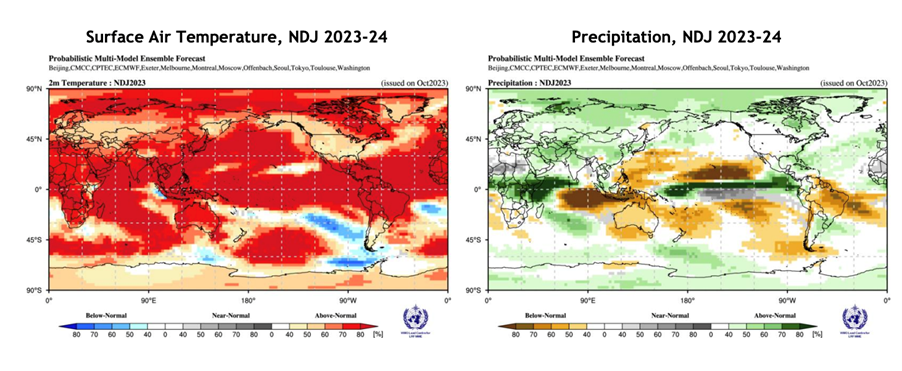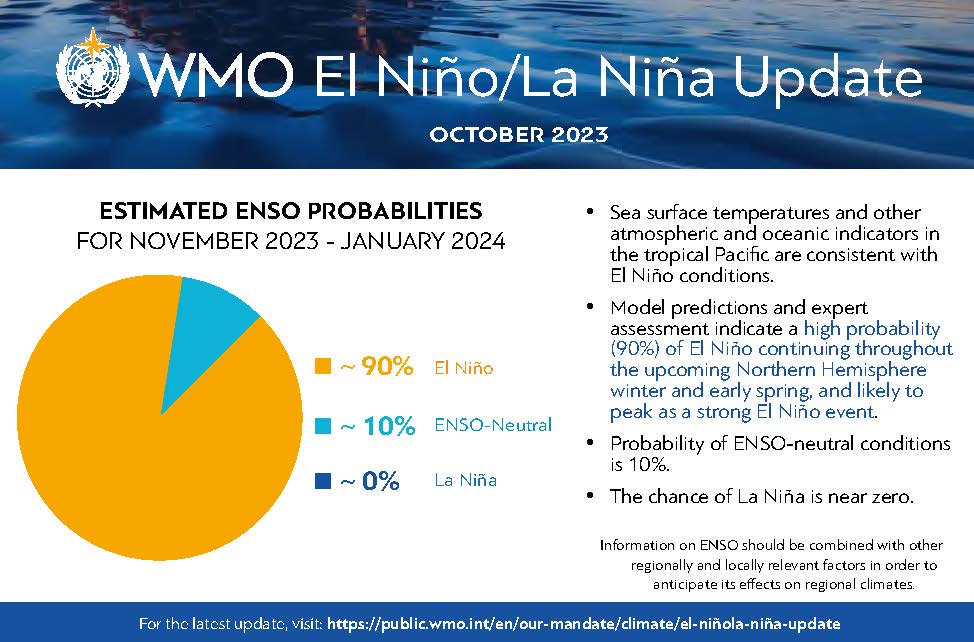El Niño Expected to Last at least until April 2024
ENVIRONMENT, 13 Nov 2023
UN World Meteorological Organization - TRANSCEND Media Service
- El Niño is expected to fuel further temperature increases
- Impacts will continue into 2024
- It will exacerbate extreme weather and climate-events, like heatwaves, floods and droughts
- Early Warnings for All save lives
8 Nov 2023 – The ongoing El Niño event is expected to last at least until April 2024, influencing weather patterns and contributing to a further spike in temperatures both on land and in the ocean, according to a new Update from the World Meteorological Organization.
As of mid-October 2023, sea surface temperatures and other atmospheric and oceanic indicators in the central-eastern tropical Pacific are consistent with El Niño, the warm phase of El Niño/Southern Oscillation (ENSO). The El Niño developed rapidly during July-August, and reached moderate strength by September, 2023 and is likely to peak as a strong event in November – January 2024. There is a 90% likelihood it will persist throughout the upcoming northern hemisphere winter/southern hemisphere summer.
Based on historical patterns and current long-range predictions, it is anticipated it will gradually diminish during the forthcoming boreal spring, says the WMO El Niño/La Niña Update, which combines forecasts and expert guidance from around the world.
El Niño occurs on average every two to seven years, and typically last nine to 12 months. It is a naturally occurring climate pattern associated with warming of the ocean surface in the central and eastern tropical Pacific Ocean. But it takes place in the context of a climate being changed by human activities.
« El Niño impacts on global temperature typically play out in the year after its development, in this case in 2024. But as a result of record high land and sea-surface temperatures since June, the year 2023 is now on track to be the warmest year on record. Next year may be even warmer. This is clearly and unequivocally due to the contribution of the increasing concentrations of heat-trapping greenhouse gases from human activities,” said WMO Secretary-General Prof. Petteri Taalas.
“Extreme events such as heatwaves, drought, wildfires, heavy rain and floods will be enhanced in some regions, with major impacts. That is why WMO is committed to the Early Warnings For All initiative to save lives and minimize economic losses,” said Prof. Taalas.
The previous warmest year on record was 2016 due to a “double whammy” of an exceptionally strong El Niño and climate change.
Since May 2023, monthly average sea surface temperature anomalies in the central-eastern equatorial Pacific have warmed significantly, rising from about 0.5 °C above average in May, 2023) to around 1.5 °C above average in September, 2023. These estimates are relative to the 1991-2020 baseline period, using the latest version of the Optimum Interpolation Sea Surface Temperature (OISST) dataset.
The most recent forecasts and expert assessment suggest a high likelihood of continued warming in the central-eastern equatorial Pacific for at least the next four overlapping 3-month seasons: November-January, December-February, January-March, and February-April 2024.
A strong El Niño does not necessarily mean strong El Niño impacts locally. It is important to note that El Niño is not the only factor that drives global and regional climate patterns, and that the magnitudes of El Niño indicators do not directly correspond to the magnitudes of their effects. No two El Niño events are alike.
Global Seasonal Climate Update
Given that ENSO is not the only driver of the Earth’s climate system, WMO also issues regular Global Seasonal Climate Updates (GSCU), which incorporate influences of the other major climate variability modes such as the North Atlantic Oscillation, the Arctic Oscillation and the Indian Ocean Dipole.

Probabilistic forecasts of surface air temperature and precipitation for the season November-January 2023-24. The baseline period is 1993–2009
“Consistent with the development of an El Niño in the equatorial central and eastern Pacific, together with the prediction of above-normal sea-surface temperatures over much of the global oceans, there is widespread prediction of above-normal temperatures over almost all land areas. The largest increase in probabilities for above-normal temperatures in the Northern Hemisphere is predicted generally south of about 40°N and in the regions north of 65°N. There are also enhanced probabilities for above-normal temperatures over most of the Southern Hemisphere.” says the GSCU for November-December-January.
Predictions for rainfall in the forthcoming three months are similar to many of the typical impacts of El Niño, including above-normal rainfall in the Greater Horn of Africa (for the remainder of the rainfall season), in Parana/La Plata basin in South America, in Southeast North America, in parts of central and eastern Asia and in a narrow band along and just north of the equator in the Pacific. Below-normal rainfall is predicted in most of northern South America, over much of Australia, in the Maritime continent (most of Indonesia, Borneo, Papua New Guinea and the Philippine Islands) and in the Pacific Ocean islands south of about 30°N, and immediately to the north of the wet band.
The WMO Updates are based on WMO Global Producing Centres of Long-Range Forecasts and are available to support governments, the United Nations, decision-makers and stakeholders in climate-sensitive sectors to mobilize preparations and protect lives and livelihoods.
More detailed interpretations of the implications of El Niño (and other factors) impacts on temperature and precipitation will be made available through the WMO Regional Climate Centres at regional level, and by National Meteorological and Hydrological Services (NMHSs) at national and local level.
________________________________________________
The World Meteorological Organization is the United Nations System’s authoritative voice on Weather, Climate and Water – www.wmo.int
Tags: Climate Change, Ecology, El Niño, Environment, Global warming, Science, Weather, World Meteorological Organization
DISCLAIMER: The statements, views and opinions expressed in pieces republished here are solely those of the authors and do not necessarily represent those of TMS. In accordance with title 17 U.S.C. section 107, this material is distributed without profit to those who have expressed a prior interest in receiving the included information for research and educational purposes. TMS has no affiliation whatsoever with the originator of this article nor is TMS endorsed or sponsored by the originator. “GO TO ORIGINAL” links are provided as a convenience to our readers and allow for verification of authenticity. However, as originating pages are often updated by their originating host sites, the versions posted may not match the versions our readers view when clicking the “GO TO ORIGINAL” links. This site contains copyrighted material the use of which has not always been specifically authorized by the copyright owner. We are making such material available in our efforts to advance understanding of environmental, political, human rights, economic, democracy, scientific, and social justice issues, etc. We believe this constitutes a ‘fair use’ of any such copyrighted material as provided for in section 107 of the US Copyright Law. In accordance with Title 17 U.S.C. Section 107, the material on this site is distributed without profit to those who have expressed a prior interest in receiving the included information for research and educational purposes. For more information go to: http://www.law.cornell.edu/uscode/17/107.shtml. If you wish to use copyrighted material from this site for purposes of your own that go beyond ‘fair use’, you must obtain permission from the copyright owner.

